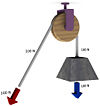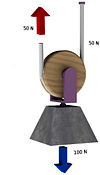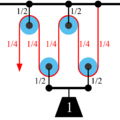Difference between revisions of "Pulley" - New World Encyclopedia
m (Removed extra spaces.) |
|||
| Line 1: | Line 1: | ||
{{Claimed}} | {{Claimed}} | ||
| − | + | ||
[[Image:PulleyShip.JPG|thumb|right|Pulleys on a ship. In this context, pulleys are usually known as [[block (sailing)|block]]s.]] | [[Image:PulleyShip.JPG|thumb|right|Pulleys on a ship. In this context, pulleys are usually known as [[block (sailing)|block]]s.]] | ||
| − | Pulleys are usually used in sets designed to reduce the amount of [[force]] needed to lift a load. However, the same amount of [[Mechanical work|work]] is necessary for the load to reach the same height as it would without the pulleys. The [[magnitude (mathematics)|magnitude]] of the force is reduced, but it must act through a longer distance. The effort needed to pull a load up is roughly the weight of the load divided by the number of wheels. | + | Pulleys are usually used in sets designed to reduce the amount of [[force]] needed to lift a load. However, the same amount of [[Mechanical work|work]] is necessary for the load to reach the same height as it would without the pulleys. The [[magnitude (mathematics)|magnitude]] of the force is reduced, but it must act through a longer distance. The effort needed to pull a load up is roughly the weight of the load divided by the number of wheels. The more wheels there are, the less efficient a system is, because of more [[friction]] between the rope and the wheels. Pulleys are one of the six [[simple machine]]s. |
| − | + | Pulleys are used in many different applications around us. Not only are they used for the obvious lifting of objects, such as a crane, but they are used in machines. Modern vehicles such as [[automobile]]s and [[airplane]]s use pulleys in their designs. Pulleys are also essential for most machines in some form or another. | |
== History == | == History == | ||
| − | + | As is the case with all the simple machines, the origin of the pulley is unknown. When early peoples lifted heavy objects by throwing vines or other crude ropes over tree limbs, they used the idea of a single fixed pulley to change the direction of a force. But since there was no wheel to turn, this use resulted in considerable friction. It is believed that by 1500 B.C.E. people in Mesopotamia used rope pulleys for hoisting water. <ref>MSN Encarta. 2007. [http://encarta.msn.com/encyclopedia_761570653_2/Pulley.html Pulley.] Retrieved June 22, 2007. </ref> | |
| − | It is not recorded when or by whom the pulley was first developed. It is believed however that [[Archimedes]] developed the first documented [[block and tackle]] pulley system, as recorded by [[Plutarch]]. Plutarch reported that Archimedes moved an entire warship, laden with men, using compound pulleys and his own strength. | + | It is not recorded when or by whom the pulley was first developed. It is believed however that [[Archimedes]] developed the first documented [[block and tackle]] pulley system, as recorded by [[Plutarch]]. Plutarch reported that Archimedes moved an entire warship, laden with men, using compound pulleys and his own strength. |
==Types of pulleys== | ==Types of pulleys== | ||
| Line 16: | Line 16: | ||
[[Image:Polea-simple-movil2.jpg|100px|thumb|right|A movable pulley.]] | [[Image:Polea-simple-movil2.jpg|100px|thumb|right|A movable pulley.]] | ||
| − | * '''Fixed''' A ''fixed'' or ''class 1'' pulley has a fixed [[axle]]. | + | * '''Fixed''' A ''fixed'' or ''class 1'' pulley has a fixed [[axle]]. That is, the axle is "fixed" or anchored in place. A fixed pulley is used to redirect the force in a rope (called a [[belt (mechanical)|belt]] when it goes in a full circle). A fixed pulley has a [[mechanical advantage]] of 1. |
| − | * '''Movable''' A ''movable'' or ''class 2'' pulley has a free axle. | + | * '''Movable''' A ''movable'' or ''class 2'' pulley has a free axle. That is, the axle is "free" to move in space. A movable pulley is used to transform forces. A movable pulley has a mechanical advantage of 2. That is, if one end of the rope is anchored, pulling on the other end of the rope will apply a doubled force to the object attached to the pulley. |
* '''Compound''' A ''compound pulley'' is a combination fixed and movable pulley system. | * '''Compound''' A ''compound pulley'' is a combination fixed and movable pulley system. | ||
** Block and tackle - A ''block and tackle'' is a compound pulley where several pulleys are mounted on each axle, further increasing the mechanical advantage. | ** Block and tackle - A ''block and tackle'' is a compound pulley where several pulleys are mounted on each axle, further increasing the mechanical advantage. | ||
| Line 23: | Line 23: | ||
Pulleys are able to change the direction of the force. | Pulleys are able to change the direction of the force. | ||
| − | == Theory of operation | + | == Theory of operation == |
<gallery> | <gallery> | ||
Image:Pulley0.png|Diagram 1 - A basic equation for a pulley: In equilibrium, the force ''F'' on the pulley axle is equal and opposite to the sum of the [[Tension (mechanics)|tension]]s in each line leaving the pulley, and these tensions are equal. | Image:Pulley0.png|Diagram 1 - A basic equation for a pulley: In equilibrium, the force ''F'' on the pulley axle is equal and opposite to the sum of the [[Tension (mechanics)|tension]]s in each line leaving the pulley, and these tensions are equal. | ||
| Line 40: | Line 40: | ||
<gallery> | <gallery> | ||
| − | Image:Pulley2.png|Diagram 3 - A simple compound pulley system - a | + | Image:Pulley2.png|Diagram 3 - A simple compound pulley system - a movable pulley and a fixed pulley lifting a unit weight. The tension in each line is one third the unit weight, yielding an advantage of 3. |
| − | Image:Pulley2a.png|Diagram 3a - A simple compound pulley system - a | + | Image:Pulley2a.png|Diagram 3a - A simple compound pulley system - a movable pulley and a fixed pulley lifting a unit weight, with an additional pulley redirecting the lifting force downward. The tension in each line is one third the unit weight, yielding an advantage of 3. |
| − | Image:Pulley3a.png|Diagram 4a - A more complicated compound pulley system. | + | Image:Pulley3a.png|Diagram 4a - A more complicated compound pulley system. The tension in each line is one quarter of the unit weight, yielding an advantage of 4. An additional pulley redirecting the lifting force has been added. |
Image:Polispasto4.jpg|Figure 4b - A practical block and tackle pulley system corresponding to diagram 4a. Note that the axles of the fixed and movable pulleys have been combined. | Image:Polispasto4.jpg|Figure 4b - A practical block and tackle pulley system corresponding to diagram 4a. Note that the axles of the fixed and movable pulleys have been combined. | ||
</gallery> | </gallery> | ||
| − | The addition of a fixed pulley to the single pulley system can yield an increase of advantage. In diagram 3, the addition of a fixed pulley | + | The addition of a fixed pulley to the single pulley system can yield an increase of advantage. In diagram 3, the addition of a fixed pulley yields a lifting advantage of 3. The tension in each line is ⅓ the unit weight, and the force on the axles of each pulley is ⅔ of a unit weight. As in the case of diagram 2a, another pulley may be added to reverse the direction of the lifting force, but with no increase in advantage. This situation is shown in diagram 3a. |
<br style="clear: left"/> | <br style="clear: left"/> | ||
| Line 54: | Line 54: | ||
== Uses of pulleys == | == Uses of pulleys == | ||
| − | + | Pulleys have been used for lifting for thousands of years. The most prevelant and oldest example are their uses on ships and boats. The block and tackle have been a key tool for raising sails and cargo. Another major use for pulleys is with cranes. | |
| − | + | Pulleys have been used also in modern times with various machines and systems. Even in the space age, pulleys have been an important aspect for the construction and operations of spacecraft and aircraft. It is with a pulley system that rudders for aircraft are controlled. | |
| + | |||
| + | The pulley is in use around us in our everyday life, from vehicles to moving equipment such as cranes. | ||
==See also== | ==See also== | ||
| Line 64: | Line 66: | ||
*[[Reel]] | *[[Reel]] | ||
*[[Winch]] | *[[Winch]] | ||
| + | |||
| + | ==Notes== | ||
| + | <references/> | ||
== References == | == References == | ||
| − | + | * Hellman, and Sweat. 1971. ''The Lever And Pulley.'' New York, NY: M. Evans and Company, Inc. ASIN B000JD0OPO. | |
| + | * Seller, Mick. 1993. ''Wheels, Pulleys and Levers.'' New York, NY: Gloucester Pr. ISBN 0531174204. | ||
| + | * Delta Education. 2000. ''Levers and Pulleys.'' Nashua, NH: Delta Education. ISBN 0875048110. | ||
== External links == | == External links == | ||
| − | + | * Brain, Marshall. 2007. [http://www.howstuffworks.com/pulley.htm How a Block and Tackle Works]. ''How Stuff Works''. Retrieved June 22, 2007. | |
| + | * Physics by Demonstrations. 1999. [http://library.thinkquest.org/27948/pulley.html The Pulley System]. Retrieved June 22, 2007. | ||
| + | * The Society of Women Engineers (SWE). [http://www.swe.org/iac/lp/pulley_03.html Lesson Plan on Pulleys]. Retrieved June 22, 2007. | ||
[[Category:Physical sciences]] | [[Category:Physical sciences]] | ||
Revision as of 20:55, 22 June 2007
Pulleys are usually used in sets designed to reduce the amount of force needed to lift a load. However, the same amount of work is necessary for the load to reach the same height as it would without the pulleys. The magnitude of the force is reduced, but it must act through a longer distance. The effort needed to pull a load up is roughly the weight of the load divided by the number of wheels. The more wheels there are, the less efficient a system is, because of more friction between the rope and the wheels. Pulleys are one of the six simple machines.
Pulleys are used in many different applications around us. Not only are they used for the obvious lifting of objects, such as a crane, but they are used in machines. Modern vehicles such as automobiles and airplanes use pulleys in their designs. Pulleys are also essential for most machines in some form or another.
History
As is the case with all the simple machines, the origin of the pulley is unknown. When early peoples lifted heavy objects by throwing vines or other crude ropes over tree limbs, they used the idea of a single fixed pulley to change the direction of a force. But since there was no wheel to turn, this use resulted in considerable friction. It is believed that by 1500 B.C.E. people in Mesopotamia used rope pulleys for hoisting water. [1]
It is not recorded when or by whom the pulley was first developed. It is believed however that Archimedes developed the first documented block and tackle pulley system, as recorded by Plutarch. Plutarch reported that Archimedes moved an entire warship, laden with men, using compound pulleys and his own strength.
Types of pulleys
- Fixed A fixed or class 1 pulley has a fixed axle. That is, the axle is "fixed" or anchored in place. A fixed pulley is used to redirect the force in a rope (called a belt when it goes in a full circle). A fixed pulley has a mechanical advantage of 1.
- Movable A movable or class 2 pulley has a free axle. That is, the axle is "free" to move in space. A movable pulley is used to transform forces. A movable pulley has a mechanical advantage of 2. That is, if one end of the rope is anchored, pulling on the other end of the rope will apply a doubled force to the object attached to the pulley.
- Compound A compound pulley is a combination fixed and movable pulley system.
- Block and tackle - A block and tackle is a compound pulley where several pulleys are mounted on each axle, further increasing the mechanical advantage.
Pulleys are able to change the direction of the force.
Theory of operation
The simplest theory of operation for a pulley system assumes that the pulleys and lines are weightless, and that there is no energy loss due to friction. It is also assumed that the lines do not stretch. With this assumption, it follows that, in equilibrium, the total force on the pulley must be zero. This means that the force on the axle of the pulley is shared equally by the two lines looping through the pulley. The situation is schematically illustrated in diagram 1. For the case where the lines are not parallel, the tensions in each line are still equal, but now the vector sum of all forces is zero. A second basic equation for the pulley follows from the conservation of energy: The product of the weight lifted times the distance it is moved is equal to the product of the lifting force (the tension in the lifting line) times the distance the lifting line is moved. The weight lifted divided by the lifting force is defined as the advantage of the pulley system. It is important to notice that the amount of work done in an ideal pulley is always the same. The work is given by the effort times the distance moved. The pulley simply allows trading effort for distance.
In diagram 2, a single movable pulley allows a unit weight to be lifted with only half the force needed to lift the weight without assistance. The total force needed is divided between the lifting force (red arrow) and the "ceiling" which is some immovable object (such as the earth). In this simple system, the lifting force is directed in the same direction as the movement of the weight. The advantage of this system is 2. Although the force needed to lift the unit weight is only half of the unit weight, we will need to draw a length of rope that is twice the distance that the weight is lifted, so that the total amount of work done (Force x distance) remains the same.
A second pulley may be added as in diagram 2a, which simply serves to redirect the lifting force downward, it does not change the advantage of the system.
The addition of a fixed pulley to the single pulley system can yield an increase of advantage. In diagram 3, the addition of a fixed pulley yields a lifting advantage of 3. The tension in each line is ⅓ the unit weight, and the force on the axles of each pulley is ⅔ of a unit weight. As in the case of diagram 2a, another pulley may be added to reverse the direction of the lifting force, but with no increase in advantage. This situation is shown in diagram 3a.
This process can be continued indefinitely for ideal pulleys with each additional pulley yielding a unit increase in advantage. For real pulleys friction among rope and pulleys will increase as more pulleys are added to the point that no advantage is possible. It puts a limit for the number of pulleys we can use in practice. The above pulley systems are known collectively as block and tackle pulley systems. In diagram 4a, a block and tackle system with advantage 4 is shown. A practical implementation in which the connection to the ceiling is combined and the fixed and movable pulleys are encased in single housings is shown in figure 4b.
Other pulley systems are possible, and some can deliver an increased advantage with fewer pulleys than the block and tackle system. The advantage of the block and tackle system is that each pulley and line is subjected to equal tensions and forces. Efficient design dictates that each line and pulley be capable of handling its load, and no more. Other pulley designs will require different strengths of line and pulleys depending on their position in the system, but a block and tackle system can use the same line size throughout, and can mount the fixed and movable pulleys on a common axle.
Uses of pulleys
Pulleys have been used for lifting for thousands of years. The most prevelant and oldest example are their uses on ships and boats. The block and tackle have been a key tool for raising sails and cargo. Another major use for pulleys is with cranes.
Pulleys have been used also in modern times with various machines and systems. Even in the space age, pulleys have been an important aspect for the construction and operations of spacecraft and aircraft. It is with a pulley system that rudders for aircraft are controlled.
The pulley is in use around us in our everyday life, from vehicles to moving equipment such as cranes.
See also
- Crane
- Hoist (device)
- Reel
- Winch
Notes
ReferencesISBN links support NWE through referral fees
- Hellman, and Sweat. 1971. The Lever And Pulley. New York, NY: M. Evans and Company, Inc. ASIN B000JD0OPO.
- Seller, Mick. 1993. Wheels, Pulleys and Levers. New York, NY: Gloucester Pr. ISBN 0531174204.
- Delta Education. 2000. Levers and Pulleys. Nashua, NH: Delta Education. ISBN 0875048110.
External links
- Brain, Marshall. 2007. How a Block and Tackle Works. How Stuff Works. Retrieved June 22, 2007.
- Physics by Demonstrations. 1999. The Pulley System. Retrieved June 22, 2007.
- The Society of Women Engineers (SWE). Lesson Plan on Pulleys. Retrieved June 22, 2007.
Credits
New World Encyclopedia writers and editors rewrote and completed the Wikipedia article in accordance with New World Encyclopedia standards. This article abides by terms of the Creative Commons CC-by-sa 3.0 License (CC-by-sa), which may be used and disseminated with proper attribution. Credit is due under the terms of this license that can reference both the New World Encyclopedia contributors and the selfless volunteer contributors of the Wikimedia Foundation. To cite this article click here for a list of acceptable citing formats.The history of earlier contributions by wikipedians is accessible to researchers here:
The history of this article since it was imported to New World Encyclopedia:
Note: Some restrictions may apply to use of individual images which are separately licensed.










